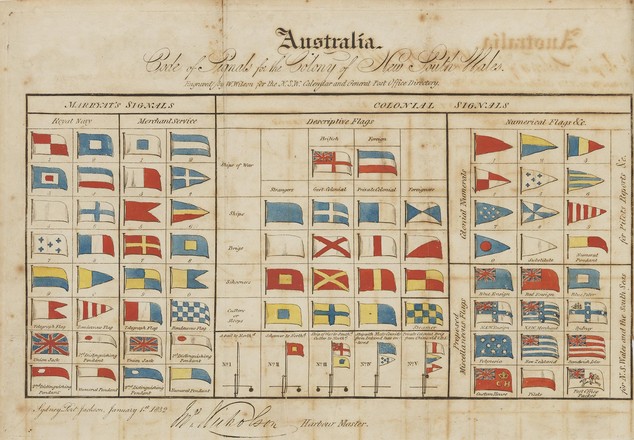Code of Signals for the Colony of New South Wales, 1 January 1832
Hand
coloured print in New South Wales Calendar and
Post Office Directory, 1832
Dixson
Library 83/353
John Nicholson, the Harbour Master
for Port Jackson (Sydney Harbour) introduced a set of signals for use in Port
Jackson in 1829. When a ship entered the harbour entrance a signal flag
was raised at South Head signal station to designate the type of vessel, its home
port, the port from which the vessel last sailed and its cargo.
The signal was received at the Fort
Phillip signal station (now the Sydney Observatory) and the same flags were
raised to inform the residents of Sydney that a ship would arrive shortly. This
was a unique and simple signal system that informed port workers of the arrival
of work, suppliers of ships needing provisioning and the public of the arrival
of letters from England and new settlers for the colony.
Ralph Bartlett (President, Flags Australia)
The Australian Ensign & the Federation Flag
By Ralph Bartlett (President, Flags Australia)
In order to boost people's support for the federation of the six
Australian colonies into one nation, the Australian Federation movement revived
the use of the Australian Ensign in the 1890s with the foundation of the Australasian
Federation League by Edmund Barton in 1893.
There is a certain irony in the Australian Federation movement's
campaign slogan created by Sir Henry Parkes: One People – One Destiny – One Flag. Australia did not have an
official national flag at this time and most Australians regarded Britain’s Union
Jack as the national flag.
The Federation Flag was so
successful and popular, that it appeared in the official NSW Government's
official Invitation to the Inaugural Celebrations for the Commonwealth of
Australia on the 1 January 1901. No steps were taken to create an
official Australian flag prior to Federation, and on 29 April 1901 that the
Federal government published invitations for a design competition for new flag
for the new Federal Government. The winning design from that competition
was announced on 3 September 1901, and today the anniversary of that design is
commemorated annually as Australian National Flag Day.
Ralph Bartlett (President, Flags Australia)
The Australian Flag
By Ralph Bartlett (President, Flags Australia)
The winning design from the new
Federal government flag competition was sent to London as a possible new flag for
Australia. The Federation Flag was also sent along as ‘Design B’ — Prime
Minister Edmund Barton thought this design also merited consideration due to
its long historical use in New South Wales. The British Colonial Office decided
in favour of the competition winning design on 20 February 1903, making it the
official flag of Australia. Use of the Australian Ensign and Federation Flag
faded into history as use of the new Australian national flag became widespread
over the next century.
Nicholson’s Chart, 1832
By Ralph Bartlett (President, Flags Australia)
Nicholson's ‘Code of Signals for
the Colony of New South Wales’ was first published in the 1829 edition of the Australian
Almanack. Some of the signals were slightly improved and in January
1832 it was published in a new publication, the New South Wales
Calendar and Post Office Directory.
The revised ‘Code of Signals for
the Colony of New South Wales’ included the internationally recognised
Marryat's Signals used by the Royal Navy and commercial shipping for ship-to-shore
messages.
Nicholson also added six new flags
to the 1832 chart. These were locally designed proposed flags for New
South Wales (NSW Ensign and NSW Merchant) and Sydney, plus proposed flags for
New Zealand, the Sandwich Islands (Hawaii) and Polynesia. This chart has
become known as the ‘Nicholson Chart’ and is regarded as the ‘founding’ flag
document of New South Wales and therefore Australia.
The NSW Ensign with its blue cross
on a white field bearing five stars was used as an unofficial flag for the
colony, as well as locally built ships. The flag design is likely to have been
an adaptation of the first version of the unofficial ‘Advance Australia’ coat
of arms, painted for Captain Thomas Silk in 1821 with its cross bearing five
stars. These unofficial arms also evolved into the official flag badge of
the NSW flag adopted in 1876 and the NSW state coat of arms adopted in 1906.
The stars are regarded as being representative of the Southern Cross.
This star-crossed flag may be one of
the possible inspirations for the Eureka flag, which has the blue and white
colours reversed, though without the Union Jack. The NSW Merchant flag may have
influenced the design of the Murray River flag in 1853. The British Admiralty
in 1883 decided that the flag, by then called the Australian Ensign, was too
similar to the Royal Navy's white ensign (with a red cross and no stars) and
prohibited its use by local shipping.



 Back to list
Back to list